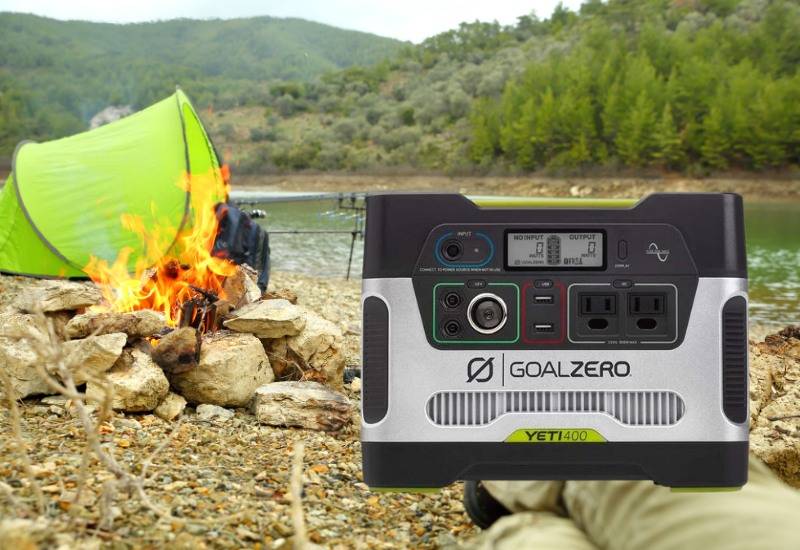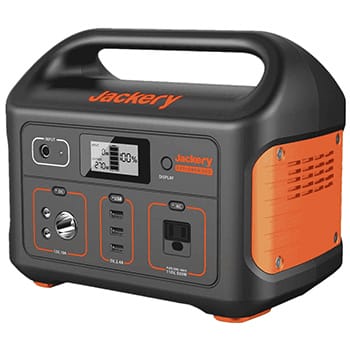I love camping. However, as most campers know, spending extended periods of time in nature presents challenges unique to modern life.
The great explorers of the past didn’t have to worry about snapping pics for the ‘gram.
As such, I’ve been trying a lot of different portable power station units lately. Now, I’ve tried a few lithium power stations, but I thought this time I’d try a lead-acid power station on my quest for portable power.
I’m sick of my phone running outta juice while camping or during a blackout, so I thought I’d see if the Goal Zero Yeti 400 would fulfill my needs.
What Is The Goal Zero Yeti 400?
The Goal Zero Yeti 400 is a solar generator that uses a lead-acid battery to power your devices and electronics on a camping trip or if you’re living off-grid.
This lead-acid battery device can charge laptops, smartphones, tablets, lights, mini-fridges, and various other devices when you’re out camping, away from the grid, or during an emergency.
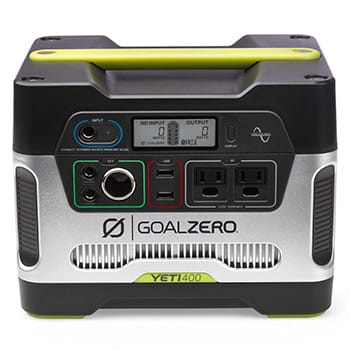
The Goal Zero Yeti 400 comes with multiple electronic ports for charging all different devices, including:
- 2 x USB ports
- 1 x 12V port
- 2 x 110V AC outlets
- Pure sine-wave inverter
There is a fold-away carry handle for easy portability, and the LCD screen display tells you all the essential information you need to know at a glance. You can see both the input and output in watts, and you can also keep an eye on the battery level so you know when you’ve got a low battery approaching.
While 400W is a decent capacity for a portable power station, it’s worth noting that this product weighs a whopping 29 lbs, which is pretty heavy for a modern power station.
However, if you’re driving to a campsite and then leaving the Yeti in your tent, then it shouldn’t be a problem. But if you lug it around during an emergency, it can be.
How Long Does The Yeti 400 Last?
In practice, this battery has a 6-month shelf life and can last around 500 life cycles before reducing to 80% battery capacity.
The Yeti is powerful enough to charge:
- A small fridge for 6+ hours
- A DSLR camera battery for 50+ charges
- A smartphone for 35+ charges
- A tablet or iPad for 10+ charges
If that sounds like enough juice for you, then this power station might be worth a shot.
What Can The Yeti 400 Power?
The Yeti 400 is good for charging smaller, everyday items that don’t have a huge power draw. It’s perfect for small appliances like mini-fridges, although you need to be mindful that they will drain the battery quite quickly.
Most people use these batteries for small digital devices like cameras, phones, and tablets while they’re in the great outdoors.
You could also use it as your home’s backup electricity generator, but it would only work for smaller devices.
Personally, I like to use the Yeti 400 to power my camping lights that keep my tent nice and visible. By the time I’ve powered by camping lights, charged my phone a few times, and charged my tablet a couple of times, I can normally get 2-3 days of use out of this thing.
How Do You Charge A Yeti 400?
You can charge a Yeti 400 in 3 main ways:
- Solar power (via a compatible solar panel kit)
- AC outlet (i.e. a regular home power outlet)
- 12V DC car charger (cigarette lighter slot)
How Long Does It Take To Charge A Goal Zero?
Depending on the charging method you choose, the amount of time it will take you to charge the battery will vary.
- Solar panel kit = 9 hours with direct sunlight
- AC outlet = 7 hours
- 12V car charger = 14+ hours
Results may vary slightly for different users and scenarios.
Goal Zero Yeti 400 Benefits
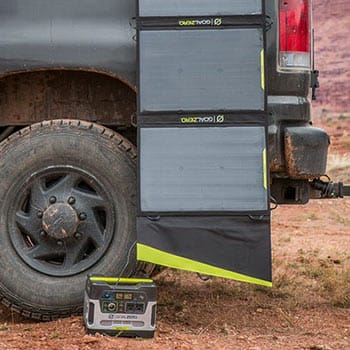
Can Be Eco-friendly
This being GreenCitizen and all, I’m obviously going to rave about any battery that is kind to Mother Earth. My reviews are almost always for products that are eco-conscious in some way.
You can charge this battery with a solar panel kit in about 9 hours on a good day, which is good if you don’t want to produce dangerous fumes or burn fossil fuels for your power.
Basically Silent
Some portable power stations can get a little noisy, especially if they’ve got fans to cool them down, but the Yeti 400 doesn’t make any noise at all.
This is ideal if you’re using it to charge devices while you’re sleeping nearby. However, the enormous weight of the battery cancels out this convenience for me.
Can Operate In High(ish) Heat
The Yeti 400 can operate in temperatures of around 32-104°F (0-40°C), which is more than enough temperature range for most people.
However, I do like to camp at the height of summer, and sometimes my tent can get very hot inside.
Now while I don’t think my tent has ever gotten to 104°F (40°C), it has gotten to the late 90s before now, which starts to make me a little nervous.
Goal Zero Yeti 400 Shortfalls
While this power station was enough for my basic camping needs, it wouldn’t be my first choice as a recommendation to people.
Sure, it’s a decent price and it does the job for many people’s needs, but there are many things about the Yeti 400 lead-acid version that is sure to influence people’s reviews.
It’s Really Friggin’ Heavy
It’s nice to know I’ve always got a backup light source in the woods with this.
But for something that’s going to charge my phone and my iPad a few times, this thing weighs A LOT. Now I understand that this is the cheaper lead-acid battery version, so it makes sense that it weighs a lot, but it’s still really infuriating.
For example, the lithium-ion battery version of the Yeti 400 comes in at just over 16 lbs, nearly half the weight. If you’re going to be moving this by long distances on foot, it’s not ideal.
It Doesn’t Come With Much
In the box, you get the Yeti 400 and then you get a single AC adaptor. That’s it.
I know that some people don’t need to use all the ports and slots on this power station, but it would be nice to have a couple of extra freebies thrown in.
I’ve had other power stations come with 12V DC car charger cables and other leads and extras thrown in, but this requires you to purchase all of that stuff separately.
It’s not the end of the world, but it’s annoying.
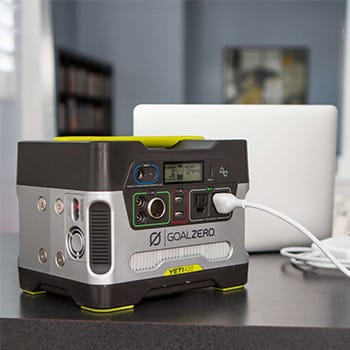
The Battery Indicator Is A Little Vague
The LCD display screen on the Yeti 400 comes with a battery indicator, but it’s a little vague, to say the least.
Basically, it shows you how much battery you have left in 20% chunks only.
So you can see whether the battery is between 0-20%, 20-40%, 40-60%, 60-80%, or 80-100%.
While I’m glad that there’s some indication of the battery level, most modern power stations like the Jackery Explorer 500 show you a specific percentage, so it feels a little outdated to be using a system like this.
The Warranty Is A Bit Short
The Yeti 400 power station comes with a 6-month warranty, which seems a little short for a product like this that costs several hundred dollars.
If you read many Yeti 400 reviews, a lot of people complain about how their power station broke just after the 6 months warranty was up, leaving them out of pocket.
That hasn’t happened to me yet, but I’m on the edge of my (outdoor) seat worrying about it.
Pros and Cons Summary of the Goal Zero Yeti 400 Solar Generator
Pros
Cons
- Can operate in high(ish) heat
- Eco-friendly solar panel charging
- LCD screen shows remaining battery life
- Pure sine wave inverter
- Comes with limited accessories
- Vague battery indication system
- Short 6-month warranty
- Expensive for what it is
- Quite a few negative/mixed customer reviews
- Can overheat in certain conditions
Things To Consider Before Buying A Portable Solar Generator
Battery Type
Some battery types are cheaper than others, but that’s often because they weigh much more and have a lower capacity than their counterparts.
For example, the best power station units come with lithium-ion batteries, and these tend to be very light. However, you’ll pay for the privilege of such a good battery.
On the flip side, older types of batteries (such as a lead-acid battery) are cheaper but can weigh twice as much as lithium batteries. Are you willing to carry around a very heavy battery for the sake of a couple of hundred dollars?
Your Power Requirements
How much power do you actually need? There’s no point in buying a 2,000W huge power station if you just need to charge your phone a few times on a camping trip.
Consider all the electronic devices in your life that will need charging on a trip. Then, estimate how many times you will need to charge each device and do the math from there.
However, if you’re looking for backup power in your home during a blackout and you want to be able to use your fridge or freezer and other large appliances, you need a considerable amount of juice.
Solar Panels Charging
If you’re after a portable power station that can be charged with solar panels, then great! That’s good for the environment and we’re all about that here at GreenCitizen.
However, certain batteries only work with certain types of solar panel kits depending on their wattage. Make sure your power station is compatible with your solar panel kit.
Ports
If you’re just charging smartphones and tablets, then a few USB ports should do the trick for your needs.
However, if you want to use laptops, mini-fridges, small TVs, and other such appliances, you’re going to need an AC outlet with enough wattage to power your items.
Frequently Asked Questions (FAQ)
Yes, the Goal Zero Yeti 400 can power a small mini refrigerator for around 5-6 hours before losing power. However, if you want to power your home’s full-size fridge or freezer during a blackout, you’ll need a larger generator.
You cannot use just any solar panel with Goal Zero. Generally speaking, you need 100W solar panel kits specifically designed to charge portable power stations with the correct cables and inputs/outputs. Goal Zero makes their own solar panels that you can use.
Most Goal Zero solar panels are waterproof and designed to withstand the elements, but it’s always worth checking the manual just to be sure. However, the power stations themselves are often not waterproof.
Press and hold the 3 buttons labeled “Units,” “Light,” and “Info” for a few seconds until the screen blanks out. This should trigger a software reset and the product should power back on within a few minutes. If it doesn’t, plug it in with an AC charger to “wake it up.”
Goal Zero Yeti 400: Should You Buy It?
While this power station was good enough to get me by on a camping trip, I wouldn’t recommend it to many people. I especially wouldn’t recommend it as backup electricity for your home — it’s just not powerful enough to cut the mustard.
I’ve also read many negative reviews and mixed reviews suggesting that it will die a painful death in the near future, so I’m scared to keep using it.
I cannot camp in fear!
If you need more power or just want a more reliable portable power station, I’d recommend the Jackery Explorer 500 instead.

